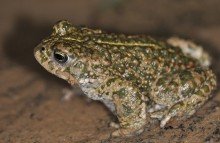Tucked next door to a newsagents, to the right side of the precinct in Boscombe, stands a little door leading up to an equally little office. It is easily passed by, despite a couple of signs marking its territory.
Behind that door is the Amphibian and Reptile Conservation Trust (ARC Trust), who were formed in 2009 and previously known as the Herpetological Conservation Trust. Their small, but committed team work to conserve the habitats of amphibians and reptiles all over the UK and by directly managing over eighty reserves in Hampshire, Surrey, Norfolk, Cumbria (and where their main offices are based) Dorset.
The Main Men
Part of the team, focusing directly on species conservation is the Amphibian Conservation Officer, John Buckley and Reptile Conservation Officer, Nick Moulton. Both are great experts in their field, and their dedication and passion for the job, despite its difficulties, can easily be read in the way they speak about their specialities.
One of John’s main focuses is the natterjack toad. This amphibian species is often found near the coast, hidden in coastal dune systems, where they breed in shallow and temporary ponds. These specific conditions for their habitat are one of the reasons why the species is rare, and they are a conservation priority for John and the team at ARC Trust. The species can be found in fewer than 60 locations over the UK, including Hengistbury Head in Dorset.
Hengistbury is protected as a Site of Special Scientific Interest (SSSI) because of its diverse habitats that cater for the rare species, and a wide range of other wildlife. Natterjack toads went extinct from the area in the 1960s, but were successfully reintroduced.
John is keen to stress however that this translocation of the species is not their first move, if it can be helped. “70% of the natterjacks in Britain are on native sites, where they have been for decades, so our first option is always to try and defend them where they are.”
Nick puts this in a matter of fact way. “Look after what you’ve got [that’s left], enhance where possible by management efforts or if you can recreate that habitat at large-scale, and reintroduce to restore former historic range. The re-introduction is mainly the icing on the cake.”
Re-introduction of a species to an area does not always go to plan. The sand lizard is another rare species, and a release of them to Hengistbury Head in the 1980s backfired, despite the conditions looking perfect. “It was a bit of an embarrassment really… but you do have to learn on the job that unfortunately these animals and their relations with the habitat can be pretty complex.
“Second attempts should work, though!”
Monitoring
If re-introduction is successful, monitoring of the species and the habitat is key. This is carried out extremely effectively at Hengistbury, which John says is because, “the site is just so well looked after by Bournemouth Borough Council and the rangers there.”
One of the rangers employed at Hengistbury is Hugh Goldsmith. Like John and Nick, Hugh’s dedication for the job is easy to measure, unlike the animals themselves.
“There have been two definite sand lizard sightings this year.” Hugh tells Nick. His statement is met with equal enthusiasm, and Nick reveals that they are hard to monitor simply because, “they just hide!Simple “presence” monitoring, proof of breeding and assessment that habitat is in good condition is all we can do.”
Fortunately, natterjacks are a little easier to monitor and count as they flock to the ponds each spring. It’s a sigh of relief that at least some data can prove that a number of the animals are thriving in the area.
One of the natterjack ponds at the bottom of Warren Hill, its place marked by the information panel ready to educate its readers on the amphibian, illustrates how hard Hugh and others at Hengistbury Head work at maintaining it; it is clean, has shallow edges, is clear of shrub and trees and Hugh explains how the pond has been lined with a concrete bowl, which allows the rangers to bring in water during the summer, or if the water level gets too low.
Every little detail is attended to in order to conserve the area, but has the double benefit of enhancing the amenity side of Hengistbury. To a first-time visitor everything looks completely natural, practically untouched, but it seems with a scientific eye, “you can actually see the balance of what’s been done to maximise public enjoyment but also to protect the habitats and animals on the ground as well” Nick explains.
John and Nick are impressed by the way it is maintained. “When people go there and enjoy the views, what they don’t realise, and what they don’t need to know, is that everything is happening just for their enjoyment…it’s all behind the scenes.”
Some of the one million visitors per year may be lucky enough to experience the animals first hand, as Hugh reveals natterjacks usually call when the water level is high, although John adds that this is not the only way. “I’ve even found that when the joggers come past thumping on the ground, they stimulate them to start calling in May and June!”
Pushing for Change
Although ground work is important, the Amphibian and Reptile Conservation Trust are always working towards influencing policy, and making sure that new legislations and policies surrounding the habitats and animals are sufficient. The team are lucky to have staff from government organisations to bring that kind of strength in.
“Everything changes in two years!” says Nick. “Everything is in a constant flux of change, and you don’t have a stable platform to work from.” The UK’s place within the European Union also means that an influence from this angle is vital. Natterjacks and sand lizards are both protected under European law, making it an offence to disturb, capture and kill them.
John says, “The thing that really concerns me are the people who are saying, ‘Oh, let’s get out of Europe’ don’t realise that Common Agricultural Policy is instrumental in enabling nature conservation to take place.”
Development is also a significant threat for some of the more widespread species of reptiles and amphibians. Nick points out that that the economy has to be kick-started, and the most obvious way to do that is via building a development. He adds that thepossible reduction of Natural England’s remit to “backstop” planning could negatively affect the balance required between planning and conservation
As both habitats and species can be protected funding is available to land owners, to look after the nature reserves that are open to the public.It’s something John is quite concerned about. “People fail to appreciate, although we pay into the community, we also get a lot back.”
That’s life
The Amphibian and Reptile Conservation Trust are skilled to deal with so many focuses, whether it is constant changes in policy, working with landowners or educating the general public, it is really amazing how much work has to go into just protecting one amphibian or reptile.
John shrugs it off. “These creatures are great really. They might be a bit ugly, a bit cold to the touch but they are rather good fun. If you’re going to enable people to experience them first hand, then of course you’ve got to have all of this conservation in place.
“People should be able to go to different places, and not have to worry about all the background activity, policy and the conservation work, and just enjoy it.”
Written by Alys Penfold, Multimedia Journalism student at Bournemouth University.
A version of this article was published in The Rock on Thursday 7th February, 2013.
Image by Chris Dresh, ARC Trust.












